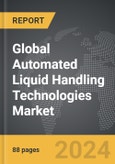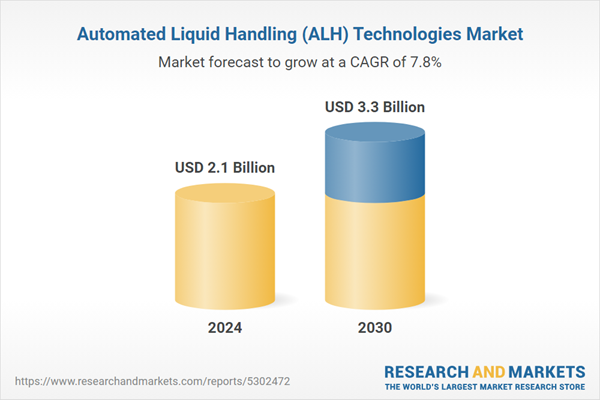Global Automated Liquid Handling (ALH) Technologies Market - Key Trends and Drivers Summarized
What Are Automated Liquid Handling Technologies and How Do They Function?
Automated Liquid Handling (ALH) technologies are advanced systems that streamline and standardize the precise movement of liquid samples in laboratory environments, making them essential tools in research, diagnostics, and drug development. These systems automate the process of liquid transfer, pipetting, and mixing, performing tasks that traditionally required meticulous manual handling by lab technicians. ALH technologies employ robotic arms and precision pipettes, capable of dispensing liquids in exact volumes with high reproducibility, minimizing human error and ensuring consistency across experiments. The versatility of ALH systems allows for programming custom protocols, handling anything from small to large volumes, and managing complex procedures such as serial dilutions, sample normalization, and assay preparations. Additionally, ALH systems are often integrated with other lab equipment and software platforms, enabling them to work in sync with laboratory information management systems (LIMS) and other analytical devices. By automating liquid handling tasks, ALH technologies free up valuable time for scientists, improve sample throughput, and significantly enhance the accuracy and reliability of experimental results.What Technological Innovations Drive the Efficiency and Precision of ALH Systems?
The efficiency and precision of Automated Liquid Handling systems are made possible by advancements in robotics, microfluidics, and software-driven automation, each contributing unique capabilities that have elevated ALH from simple pipetting machines to complex, integrated laboratory solutions. Robotics innovations have been instrumental, providing ALH systems with highly dexterous arms and precision pipettes capable of handling even the smallest liquid volumes with consistent accuracy, a critical requirement in fields such as genomics and drug discovery. Microfluidic technologies further enhance ALH by allowing the manipulation of minuscule liquid quantities on lab-on-a-chip devices, reducing reagent consumption and enabling high-throughput screening in limited spaces. Advanced software algorithms enable sophisticated programming and control over ALH processes, allowing for real-time adjustments in liquid volumes, mixing speeds, and pipetting patterns based on experimental conditions. Many ALH platforms also use machine learning algorithms to optimize pipetting accuracy by compensating for liquid viscosity, volume, and environmental conditions. Furthermore, ALH systems often integrate with laboratory information management systems (LIMS), providing seamless data transfer, tracking, and storage capabilities. These technological innovations make ALH systems highly adaptable to different lab settings and protocols, increasing both their efficiency and their potential to handle complex experimental workflows in a wide range of scientific applications.Where Are Automated Liquid Handling Technologies Making the Greatest Impact?
Automated Liquid Handling technologies have become transformative in laboratories across multiple disciplines, including genomics, clinical diagnostics, drug discovery, and biomanufacturing, where precision and high-throughput capabilities are essential. In genomics research, ALH systems enable the automation of DNA/RNA extraction, PCR setup, and sequencing preparation, facilitating the rapid processing of large sample volumes needed for population-scale studies. This level of automation is particularly critical in fields like personalized medicine and epidemiology, where researchers require high-quality genetic data from thousands of samples. Clinical diagnostics laboratories also benefit significantly from ALH, using these systems to automate routine sample preparation and assay setups, which reduces turnaround time for test results and minimizes potential contamination. In drug discovery and pharmaceutical research, ALH technologies play a vital role in high-throughput screening, where they can precisely handle thousands of compound samples for testing against target biomolecules, accelerating the identification of potential drug candidates. Additionally, ALH systems are widely used in biomanufacturing, where they assist in quality control and monitoring by automating processes such as sample dilution, reagent mixing, and cell culture maintenance. These capabilities are indispensable in settings that require precise and repeatable workflows, as they ensure that experimental conditions are consistently maintained, ultimately enhancing productivity, data quality, and reproducibility across a variety of scientific fields.What Is Driving the Growth of the Automated Liquid Handling Market?
The growth in the Automated Liquid Handling market is driven by several factors that reflect technological advancements, increased demand for high-throughput lab processes, and a shift towards more reproducible and error-free workflows in scientific research. One primary driver is the surge in demand for precision and scalability in genomics, proteomics, and drug discovery, where research increasingly relies on processing vast numbers of samples quickly and accurately. As laboratories strive to increase their throughput without compromising data quality, ALH systems offer an efficient solution by automating time-intensive pipetting tasks, thereby reducing human error and enabling the reliable scaling of experiments. Another critical factor is the expansion of personalized medicine, which demands highly accurate and reproducible lab procedures to analyze individual genetic and biomarker data, making ALH technology indispensable in molecular diagnostics. The market also benefits from the growing need for rapid, automated testing and sample processing has highlighted the value of ALH systems in both diagnostics and research. Additionally, technological advancements, particularly in robotics and artificial intelligence, have made ALH systems more flexible, affordable, and accessible, encouraging adoption across labs of all sizes. The integration of ALH with laboratory information management systems (LIMS) and data analytics platforms also enhances the appeal of these technologies, as it enables seamless data handling, traceability, and automation of complex workflows. Finally, as labs increasingly prioritize operational efficiency and waste reduction, ALH systems contribute by minimizing reagent use and optimizing liquid handling processes, supporting the trend towards sustainable lab practices. Collectively, these factors underscore the increasing adoption of ALH technologies, positioning them as essential tools in modern laboratory workflows and scientific discovery.Report Scope
The report analyzes the Automated Liquid Handling (ALH) Technologies market, presented in terms of market value (US$ Thousand). The analysis covers the key segments and geographic regions outlined below.- Segments: Product (Automated Liquid Handling Workstations, Reagents & Consumables); Application (Drug Discovery & ADME-Tox Research, Bioprocessing / Biotechnology, Cancer & Genomic Research, Other Applications); End-Use (Pharma & Biotech Companies, Academic & Research Institutes, Contract Research Organizations).
- Geographic Regions/Countries:World; United States; Canada; Japan; China; Europe (France; Germany; Italy; United Kingdom; Spain; Russia; and Rest of Europe); Asia-Pacific (Australia; India; South Korea; and Rest of Asia-Pacific); Latin America (Argentina; Brazil; Mexico; and Rest of Latin America); Middle East (Iran; Israel; Saudi Arabia; United Arab Emirates; and Rest of Middle East); and Africa.
Key Insights:
- Market Growth: Understand the significant growth trajectory of the Automated Liquid Handling Workstations segment, which is expected to reach US$2.3 Billion by 2030 with a CAGR of a 7.6%. The Reagents & Consumables segment is also set to grow at 8% CAGR over the analysis period.
Why You Should Buy This Report:
- Detailed Market Analysis: Access a thorough analysis of the Global Automated Liquid Handling (ALH) Technologies Market, covering all major geographic regions and market segments.
- Competitive Insights: Get an overview of the competitive landscape, including the market presence of major players across different geographies.
- Future Trends and Drivers: Understand the key trends and drivers shaping the future of the Global Automated Liquid Handling (ALH) Technologies Market.
- Actionable Insights: Benefit from actionable insights that can help you identify new revenue opportunities and make strategic business decisions.
Key Questions Answered:
- How is the Global Automated Liquid Handling (ALH) Technologies Market expected to evolve by 2030?
- What are the main drivers and restraints affecting the market?
- Which market segments will grow the most over the forecast period?
- How will market shares for different regions and segments change by 2030?
- Who are the leading players in the market, and what are their prospects?
Report Features:
- Comprehensive Market Data: Independent analysis of annual sales and market forecasts in US$ Million from 2024 to 2030.
- In-Depth Regional Analysis: Detailed insights into key markets, including the U.S., China, Japan, Canada, Europe, Asia-Pacific, Latin America, Middle East, and Africa.
- Company Profiles: Coverage of players such as Agilent Technologies, Analytik Jena AG, Aurora Biomed, Inc., Autogen, Inc., BioTek Instruments, Inc. and more.
- Complimentary Updates: Receive free report updates for one year to keep you informed of the latest market developments.
Some of the 32 companies featured in this Automated Liquid Handling (ALH) Technologies market report include:
- Agilent Technologies
- Analytik Jena AG
- Aurora Biomed, Inc.
- Autogen, Inc.
- BioTek Instruments, Inc.
- Corning Incorporated
- Danaher
- Eppendorf AG
- Formulatrix, Inc.
- Gilson, Inc.
This edition integrates the latest global trade and economic shifts into comprehensive market analysis. Key updates include:
- Tariff and Trade Impact: Insights into global tariff negotiations across 180+ countries, with analysis of supply chain turbulence, sourcing disruptions, and geographic realignment. Special focus on 2025 as a pivotal year for trade tensions, including updated perspectives on the Trump-era tariffs.
- Adjusted Forecasts and Analytics: Revised global and regional market forecasts through 2030, incorporating tariff effects, economic uncertainty, and structural changes in globalization. Includes historical analysis from 2015 to 2023.
- Strategic Market Dynamics: Evaluation of revised market prospects, regional outlooks, and key economic indicators such as population and urbanization trends.
- Innovation & Technology Trends: Latest developments in product and process innovation, emerging technologies, and key industry drivers shaping the competitive landscape.
- Competitive Intelligence: Updated global market share estimates for 2025, competitive positioning of major players (Strong/Active/Niche/Trivial), and refined focus on leading global brands and core players.
- Expert Insight & Commentary: Strategic analysis from economists, trade experts, and domain specialists to contextualize market shifts and identify emerging opportunities.
Table of Contents
Companies Mentioned (Partial List)
A selection of companies mentioned in this report includes, but is not limited to:
- Agilent Technologies
- Analytik Jena AG
- Aurora Biomed, Inc.
- Autogen, Inc.
- BioTek Instruments, Inc.
- Corning Incorporated
- Danaher
- Eppendorf AG
- Formulatrix, Inc.
- Gilson, Inc.
Table Information
| Report Attribute | Details |
|---|---|
| No. of Pages | 365 |
| Published | December 2025 |
| Forecast Period | 2024 - 2030 |
| Estimated Market Value ( USD | $ 2.1 Billion |
| Forecasted Market Value ( USD | $ 3.3 Billion |
| Compound Annual Growth Rate | 7.8% |
| Regions Covered | Global |









